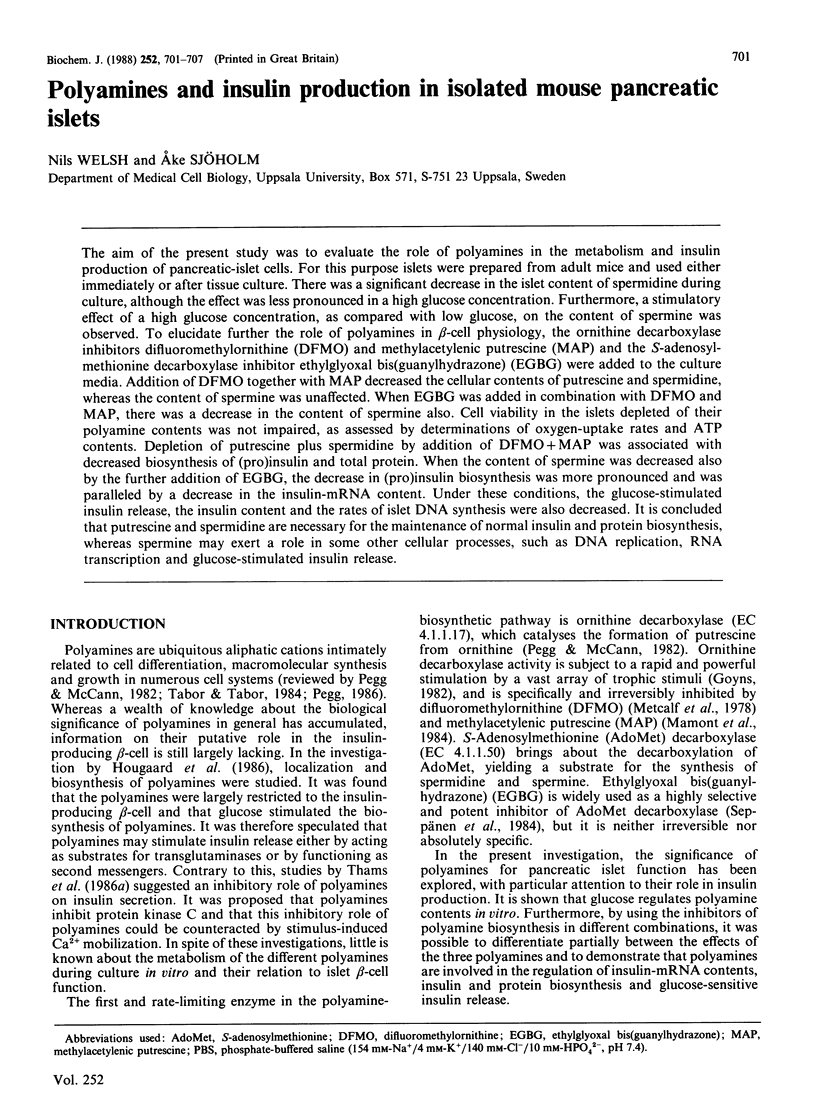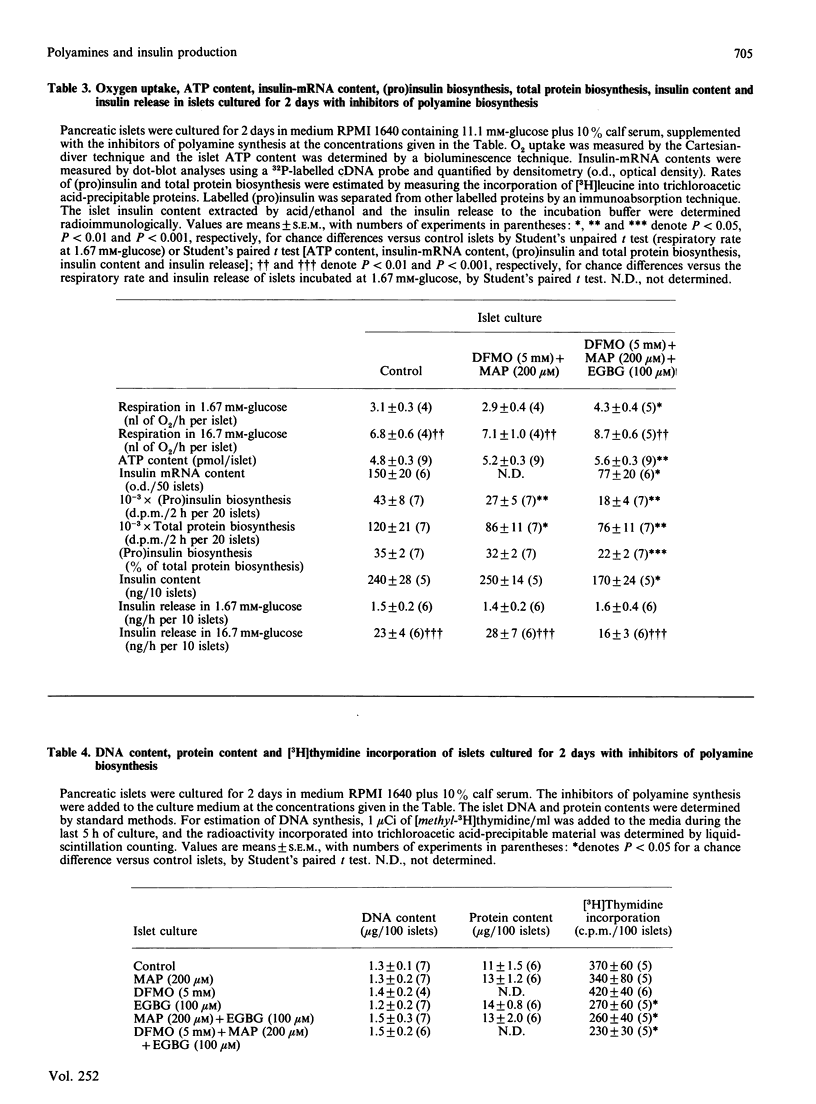Abstract
The aim of the present study was to evaluate the role of polyamines in the metabolism and insulin production of pancreatic-islet cells. For this purpose islets were prepared from adult mice and used either immediately or after tissue culture. There was a significant decrease in the islet content of spermidine during culture, although the effect was less pronounced in a high glucose concentration. Furthermore, a stimulatory effect of a high glucose concentration, as compared with low guclose, on the content of spermine was observed. To elucidate further the role of polyamaines in beta-cell physiology, the ornithine decarboxylase inhibitors difuoromethylornithine (DFMO) and methylacetylenic putrescine (MAP) and the S-adenosylmethionine decarboxylase inhibitor ethylglyoxal bis(guanylhydrazone) (EGBG) were added to the culture media. Addition of DFMO together with MAP decreased the cellular contents of putrescine and spermidine, whereas the content of sperimine was unaffected. When EGBG was added in combination with DFMO and MAP, there was a decrease in the content of spermine also. Cell viability in the islets depleted of their polyamine contents was not impaired, as assessed by determinations of oxygen-uptake rates and ATP contents. Depletion of putescine plus spermidine by addition of DFMO+MAP was associated with decreased biosynthesis of (pro)insulin and total protein. When the content of spermine was decreased also by the further addition of EGBG, the decrease in (pro) insulin biosynthesis was more pronounced and was paralleled by a decrease in the insulin-mRNA content. Under these conditions, the glucose-stimulated insulin release, the insulin content and the rates of islet DNA synthesis were also decreased. It is concluded that putrescine and spermidine are necessary for the maintenance of normal insulin and protein biosynthesis, whereas spermine may exert a role in some other cellular processes, such as DNA replication, RNA transcription and glucose-stimulated insulin release.
Full text
PDF






Selected References
These references are in PubMed. This may not be the complete list of references from this article.
- Bachrach U., Shtorch A. Formation of cadaverine as an effect of alpha-difluoromethylornithine on chick embryo fibroblasts transformed by rous sarcoma virus. Cancer Res. 1985 May;45(5):2159–2164. [PubMed] [Google Scholar]
- Berne C. Anti-insulin serum coupled to Sepharose 4B as a tool for the investigation of insulin biosynthesis in the B-cells of obese hyperglycemic mice. Endocrinology. 1975 Nov;97(5):1241–1247. doi: 10.1210/endo-97-5-1241. [DOI] [PubMed] [Google Scholar]
- Blair D. G. Activation of mammalian RNA polymerases by polyamines. Int J Biochem. 1985;17(1):23–30. doi: 10.1016/0020-711x(85)90081-3. [DOI] [PubMed] [Google Scholar]
- Bolkenius F. N., Seiler N. The role of polyamine reutilization in depletion of cellular stores of polyamines in non-proliferating tissues. Biochim Biophys Acta. 1987 Jan 20;923(1):125–135. doi: 10.1016/0304-4165(87)90135-8. [DOI] [PubMed] [Google Scholar]
- Caldarera C. M., Casti A., Guarnieri C., Moruzzi G. Polyamine and nucleoprotein correlations in hypertrophied and perfused heart. Recent Adv Stud Cardiac Struct Metab. 1975;7:91–97. [PubMed] [Google Scholar]
- Chan S. J., Noyes B. E., Agarwal K. L., Steiner D. F. Construction and selection of recombinant plasmids containing full-length complementary DNAs corresponding to rat insulins I and II. Proc Natl Acad Sci U S A. 1979 Oct;76(10):5036–5040. doi: 10.1073/pnas.76.10.5036. [DOI] [PMC free article] [PubMed] [Google Scholar]
- Gomis R., Sener A., Malaisse-Lagae F., Malaisse W. J. Transglutaminase activity in pancreatic islets. Biochim Biophys Acta. 1983 Nov 8;760(3):384–388. doi: 10.1016/0304-4165(83)90378-1. [DOI] [PubMed] [Google Scholar]
- Goyns M. H. The role of polyamines in animal cell physiology. J Theor Biol. 1982 Aug 21;97(4):577–589. doi: 10.1016/0022-5193(82)90359-9. [DOI] [PubMed] [Google Scholar]
- Heding L. G. Determination of total serum insulin (IRI) in insulin-treated diabetic patients. Diabetologia. 1972 Aug;8(4):260–266. doi: 10.1007/BF01225569. [DOI] [PubMed] [Google Scholar]
- Hinegardner R. T. An improved fluorometric assay for DNA. Anal Biochem. 1971 Jan;39(1):197–201. doi: 10.1016/0003-2697(71)90476-3. [DOI] [PubMed] [Google Scholar]
- Hougaard D. M., Nielsen J. H., Larsson L. I. Localization and biosynthesis of polyamines in insulin-producing cells. Biochem J. 1986 Aug 15;238(1):43–47. doi: 10.1042/bj2380043. [DOI] [PMC free article] [PubMed] [Google Scholar]
- Howell S. L., Taylor K. W. Potassium ions and the secretion of insulin by islets of Langerhans incubated in vitro. Biochem J. 1968 Jun;108(1):17–24. doi: 10.1042/bj1080017. [DOI] [PMC free article] [PubMed] [Google Scholar]
- KISSANE J. M., ROBINS E. The fluorometric measurement of deoxyribonucleic acid in animal tissues with special reference to the central nervous system. J Biol Chem. 1958 Jul;233(1):184–188. [PubMed] [Google Scholar]
- Kakegawa T., Hirose S., Kashiwagi K., Igarashi K. Effect of polyamines on in vitro reconstitution of ribosomal subunits. Eur J Biochem. 1986 Jul 15;158(2):265–269. doi: 10.1111/j.1432-1033.1986.tb09746.x. [DOI] [PubMed] [Google Scholar]
- Karpetsky T. P., Hieter P. A., Frank J. J., Levy C. C. Polyamines, ribonucleases, and the stability of RNA. Mol Cell Biochem. 1977 Sep 9;17(2):89–99. doi: 10.1007/BF01743432. [DOI] [PubMed] [Google Scholar]
- Koenig H., Goldstone A., Lu C. Y. Polyamines regulate calcium fluxes in a rapid plasma membrane response. Nature. 1983 Oct 6;305(5934):530–534. doi: 10.1038/305530a0. [DOI] [PubMed] [Google Scholar]
- LOWRY O. H., ROSEBROUGH N. J., FARR A. L., RANDALL R. J. Protein measurement with the Folin phenol reagent. J Biol Chem. 1951 Nov;193(1):265–275. [PubMed] [Google Scholar]
- Lernmark A., Nathans A., Steiner D. F. Preparation and characterization of plasma membrane-enriched fractions from rat pancreatic islets. J Cell Biol. 1976 Nov;71(2):606–623. doi: 10.1083/jcb.71.2.606. [DOI] [PMC free article] [PubMed] [Google Scholar]
- Mamont P. S., Siat M., Joder-Ohlenbusch A. M., Bernhardt A., Casara P. Effects of (2R, 5R)-6-heptyne-2,5-diamine, a potent inhibitor of L-ornithine decarboxylase, on rat hepatoma cells cultured in vitro. Eur J Biochem. 1984 Aug 1;142(3):457–463. doi: 10.1111/j.1432-1033.1984.tb08308.x. [DOI] [PubMed] [Google Scholar]
- Meggio F., Flamigni F., Caldarera C. M., Guarnieri C., Pinna L. A. Phosphorylation of rat heart ornithine decarboxylase by type-2 casein kinase. Biochem Biophys Res Commun. 1984 Aug 16;122(3):997–1004. doi: 10.1016/0006-291x(84)91190-2. [DOI] [PubMed] [Google Scholar]
- Mustelin T., Pösö H., Lapinjoki S. P., Gynther J., Andersson L. C. Growth signal transduction: rapid activation of covalently bound ornithine decarboxylase during phosphatidylinositol breakdown. Cell. 1987 Apr 24;49(2):171–176. doi: 10.1016/0092-8674(87)90557-5. [DOI] [PubMed] [Google Scholar]
- Oredsson S. M., Kanje M., Mamont P. S., Wagner J., Heby O. Polyamine depletion increases cellular ribonucleotide levels. Mol Cell Biochem. 1986 Apr;70(1):89–96. doi: 10.1007/BF00233806. [DOI] [PubMed] [Google Scholar]
- Park M. H., Cooper H. L., Folk J. E. Identification of hypusine, an unusual amino acid, in a protein from human lymphocytes and of spermidine as its biosynthetic precursor. Proc Natl Acad Sci U S A. 1981 May;78(5):2869–2873. doi: 10.1073/pnas.78.5.2869. [DOI] [PMC free article] [PubMed] [Google Scholar]
- Pegg A. E., McCann P. P. Polyamine metabolism and function. Am J Physiol. 1982 Nov;243(5):C212–C221. doi: 10.1152/ajpcell.1982.243.5.C212. [DOI] [PubMed] [Google Scholar]
- Pegg A. E. Recent advances in the biochemistry of polyamines in eukaryotes. Biochem J. 1986 Mar 1;234(2):249–262. doi: 10.1042/bj2340249. [DOI] [PMC free article] [PubMed] [Google Scholar]
- Seiler N. Liquid chromatographic methods for assaying polyamines using prechromatographic derivatization. Methods Enzymol. 1983;94:10–25. doi: 10.1016/s0076-6879(83)94004-1. [DOI] [PubMed] [Google Scholar]
- Seppänen P., Ruohola H., Jänne J. Ethylglyoxal bis(guanylhydrazone) as an inhibitor of polyamine biosynthesis in L1210 leukemia cells. Biochim Biophys Acta. 1984 Apr 16;803(4):331–337. doi: 10.1016/0167-4889(84)90125-3. [DOI] [PubMed] [Google Scholar]
- TABOR C. W., TABOR H., BACHRACH U. IDENTIFICATION OF THE AMINOALDEHYDES PRODUCED BY THE OXIDATION OF SPERMINE AND SPERMIDINE WITH PURIFIED PLASMA AMINE OXIDASE. J Biol Chem. 1964 Jul;239:2194–2203. [PubMed] [Google Scholar]
- Tabor C. W., Tabor H. Polyamines. Annu Rev Biochem. 1984;53:749–790. doi: 10.1146/annurev.bi.53.070184.003533. [DOI] [PubMed] [Google Scholar]
- Thams P., Capito K., Hedeskov C. J. An inhibitory role for polyamines in protein kinase C activation and insulin secretion in mouse pancreatic islets. Biochem J. 1986 Jul 1;237(1):131–138. doi: 10.1042/bj2370131. [DOI] [PMC free article] [PubMed] [Google Scholar]
- Thams P., Capito K., Hedeskov C. J. Polyamine-enhanced casein kinase II in mouse pancreatic islets. Diabetologia. 1986 Dec;29(12):888–892. doi: 10.1007/BF00870145. [DOI] [PubMed] [Google Scholar]
- Thomas P. S. Hybridization of denatured RNA and small DNA fragments transferred to nitrocellulose. Proc Natl Acad Sci U S A. 1980 Sep;77(9):5201–5205. doi: 10.1073/pnas.77.9.5201. [DOI] [PMC free article] [PubMed] [Google Scholar]
- White B. A., Bancroft F. C. Cytoplasmic dot hybridization. Simple analysis of relative mRNA levels in multiple small cell or tissue samples. J Biol Chem. 1982 Aug 10;257(15):8569–8572. [PubMed] [Google Scholar]
- Yung M. W., Green C. The binding of polyamines to phospholipid bilayers. Biochem Pharmacol. 1986 Nov 15;35(22):4037–4041. doi: 10.1016/0006-2952(86)90024-9. [DOI] [PubMed] [Google Scholar]


